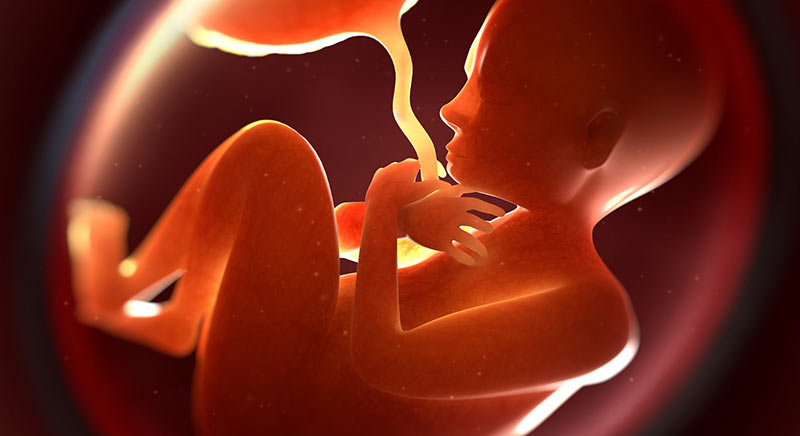What are the signs of pregnancy?
In many cases, the first sign of pregnancy is a missed menstrual period. Most pregnancy tests give a positive result when the menstrual period is missed. Other early pregnancy symptoms include tiredness, bloating, more frequent urination, changes in mood, nausea, and swelling and tenderness in the breasts. These symptoms do not all appear together in all cases, but it is common to have at least 1 of them.
What happens in the first month of pregnancy?
The pregnancy is divided into 3 trimesters. Each quarter lasts just over 13 weeks. The first month marks the beginning of the first quarter.
Stages of Pregnancy:
Pregnancy consists of approximately 40 weeks from the first day of your last menstrual period. The weeks are grouped into three quarters. Find out what happens to you and the baby in these three stages.
First trimester (from week 1 to 12)
During the first trimester, the body goes through many changes. Hormonal changes affect practically all organ systems. These changes can manifest symptoms even in the first weeks of pregnancy. Menstrual delay is an obvious sign of pregnancy. Other changes may include:
- Exhaustion
- Sensitive and inflamed breasts. The nipples can also become protruding.
- Stomach ache; vomiting may occur (morning sickness)
- Desire towards or dislike of certain foods
- Humor changes
- Constipation (difficulty passing stool)
- Need to urinate more frequently
- Headache
- Acidity
- Weight gain or loss
As the body changes, you probably need to make changes to your daily routine; for example, going to bed earlier or eating more frequently but in small amounts. Fortunately, most of these discomforts will go away over time. And some women feel nothing at all. If you have been pregnant before, you may feel different this time. All women are different; the same goes for pregnancies.
Second trimester (from week 13 to 28)
Most women feel that the second trimester of pregnancy is easier to carry than the first. Still, it’s just as important to stay informed about pregnancy during these months.
You will notice that some symptoms, such as nausea and fatigue, will disappear. But now there will be new changes in the body that will be more evident. The abdomen will expand according to the baby’s growth. And before this trimester ends, you will feel the baby begin to move.
As your body changes to make room for the baby, you will likely have:
- Stretch marks on the abdomen, breasts, thighs or buttocks
- Darkening of the areolas
- A line on the skin that extends from the navel to pubic hair
- Dark spots on the skin, particularly on the cheeks, forehead, nose, or upper lip. They usually occur on both sides of the face. It is known as the mask of pregnancy.
- Numbness or tingling in the hands, called carpal tunnel syndrome
- Itchy abdomen, palms, and soles of the feet. (Contact your doctor if you have nausea, loss of appetite, vomiting, jaundice, or fatigue along with itching. This may indicate serious liver problems.)
- Swelling in the ankles, fingers and face. (If you notice any sudden or extreme swelling or if you gain weight rapidly, contact your doctor immediately. This may be a sign of preeclampsia .)
Third trimester (from week 29 to 40)
You are in the final stretch! Some of the second trimester discomfort will continue. Also, many women feel short of breath and need to go to the bathroom more often. This is because the baby is growing bigger and bigger and putting more pressure on the organs. Don’t worry, baby is fine and these problems will ease once you give birth.
Body changes you’ll notice in the third trimester include:
- Shortness of breath
- Acidity
- Swelling in the ankles, fingers and face. (If you notice any sudden or extreme swelling or if you gain weight rapidly, contact your doctor immediately. This may be a sign of preeclampsia.)
- Hemorrhoids
- Breast tenderness; may secrete an aqueous substance that is the precursor liquid to milk called colostrum
- Bulging navel
- Difficulty falling asleep
- The baby’s displacement towards the lower part of your abdomen
- Contractions, which may indicate actual labor or a false alarm
The closer you get to your due date, the cervix becomes thinner and smoother (this process is known as effacement). This is a normal, natural process that helps the birth canal (vagina) open during labor. The doctor will monitor progress with a vaginal exam as the due date approaches. Cheer up, the countdown has started!
Baby growth
First trimester (from week 1 to 12)
From four to five Weeks:
- The brain and spinal cord begin to develop.
- The heart begins to form.
- Bumps appear that will later become arms and legs.
- Right now, your baby is an embryo that is 0.04 “.
At eight weeks:
- All major organs and external body structures have already begun to form.
- The baby’s heart rate is constant.
- The arms and legs lengthen and the fingers and toes begin to form.
- The sexual organs begin to develop.
- The eyes move forward and the eyelids form.
- The umbilical cord can be seen clearly.
- At eight weeks old, your baby is a fetus and has a more human appearance. Baby is approximately 1 “long and weighs less than 0.125 ounces.
At 12 weeks:
- The nerves and muscles begin to work together. The baby can clench his fist.
- The external sexual organs allow to know the sex of the baby. For this, an ultrasound will be necessary from the second trimester.
- The eyelids are closed to protect the developing eyes. They won’t open again until the 28th week.
- The rate at which the head grew decreases and the baby is already much longer. Now 3 “long, the baby weighs almost an ounce.
Second trimester (from week 13 to 28)
At 16 weeks:
- Muscle and bone tissues continue to form and create a fuller skeleton.
- The skin begins to form. You can’t practically see through it.
- Meconium forms in the baby’s intestinal tract. This will be your first deposition.
- The baby makes sucking movements with the mouth (sucking reflex).
- Baby is 4-5 “long and weighs about 3 ounces.
At 20 weeks:
- The baby becomes more active. Maybe you can feel how it moves.
- The baby is covered with fine, soft hair called lanugo and a waxy coat called vernix. This protects the developing skin.
- Eyebrows, eyelashes, and fingernails have already formed. The baby can even scratch himself.
- Baby can hear and swallow.
- Midway through, the baby is 6 “long and weighs about 9 ounces.
At 24 weeks:
- The bone marrow begins to make blood cells.
- Taste buds are formed.
- The baby already has fingerprints.
- Real hair begins to grow on the baby’s head.
- The lungs are already formed but are still not working.
- The grip or grasp reflex and the startle or Moro reflex develop.
- The baby falls asleep and wakes periodically.
- If the baby is a boy, the testicles begin to move from the abdomen to the scrotum. If you are a girl, your uterus and ovaries are in place and the eggs that will expel the ovaries have been formed throughout your life.
- The baby accumulates fat and has gained weight considerably. Now 12 “long, the baby weighs about 1½ pounds.
Third trimester (from week 29 to 40)
At 32 weeks:
- His bones are fully formed but still soft.
- The baby’s kicks and punches are energetic.
- It can open and close the eyes and also has sensitivity to light.
- The lungs are not fully formed, but there are “breathing” movements that serve as practice.
- The baby’s body begins to store vital minerals, such as iron and calcium.
- The lanugo begins to fall.
- The baby gains weight rapidly, about half a pound a week. Your baby is now 15 “to 17” long and weighs 4 to 4½ pounds.
At 36 weeks:
- The protective waxy layer called vernix becomes thicker.
- Increase body fat. The baby continues to grow and has less room to move. The movements are no longer as strong, but you will feel it stretch and shake.
- Your baby is 16 “to 19” long and weighs 6 to 6½ pounds.
37-40 weeks:
- At 39 weeks, the baby is considered to be full-term. Baby’s organs are ready to function on their own.
- As the due date approaches, the baby turns upside down and takes a suitable position for delivery. Most babies sit in this position.
- At birth, your baby will weigh between 6 pounds 2 ounces and 9 pounds 2 ounces and will be between 19 and 21 inches long. The vast majority of full-term babies have these measurements. However, they can also be born with other measures and be healthy anyway.
What are the symptoms of pregnancy in the tenth month?
Towards the end of pregnancy, the uterus expanded from the pelvis to the bottom of the rib cage. Symptoms of pregnancy in the tenth month depend largely on when the fetus descends to the lowest part of the uterus.
Difficulty breathing, heartburn, and constipation generally improve when the fetus descends. But the lower position of the fetus in the pelvis causes frequent urination and problems with holding urine.
The cervix will begin to open (dilate) in preparation for delivery. This can happen a few weeks before delivery or it could start when you go into labor. You may feel shooting pains in your vagina as the cervix dilates.
After giving birth to the newborn, the placenta and other tissues also leave the body. This is called “delivery.”










